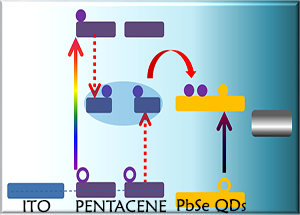In addition to various solar cell device architectures, in our group, we are fabricating hybrid solar cells that contain layers of organic and inorganic based materials. Organic based materials such as pentacene is one of the special materials we use. It is capable of undergoing singlet fission process-a process that may double the solar cell efficiency in future.
Singlet exciton fission is a well-established process in organic semiconductors. In singlet fission a photogenerated singlet exciton couples to a nearby molecule in the ground state and relaxes to a pair of lower-energy triplet excitons. The relaxed triplet exciton energy (0.86 eV) of pentacene is less than half of the singlet energy (1.83 eV) and it undergoes singlet fission within 80 fs. As represented in the picture, pentacene absorbs high energy photons, and undergoes singlet fission creating two triplets. The direct effect of the singlet fission process is to double the photocurrent in solar cells as each of the two triplets can generate charge after dissociation at a suitable interface. After the dissociation, these triplet excitons can be collected by an infrared absorbing quantum dots which have an optical band gap comparable to the pentacene.
http://onlinelibrary.wiley.com/doi/10.1002/adfm.201401816/full
References:
Jadhav, P. J., Mohanty, A., Sussman, J., Lee, J. & Baldo, M. A. Singlet Exciton Fission in Nanostructured Organic Solar Cells. Nano Lett. 11, 1495–1498 (2011).
Smith, M. B. & Michl, J. Singlet fission. Chem. Rev. 110, 6891–936 (2010).
Wilson, M. W. B. et al. Ultrafast Dynamics of Exciton Fission in Polycrystalline Pentacene. J. Am. Chem. Soc. 133, 11830–11833 (2011).
Rei Vilar, M., Heyman, M. & Schott, M. Spectroscopy of low-energy electrons backscattered from an organic solid surface: pentacene. Chem. Phys. Lett. 94, 522–526 (1983).

